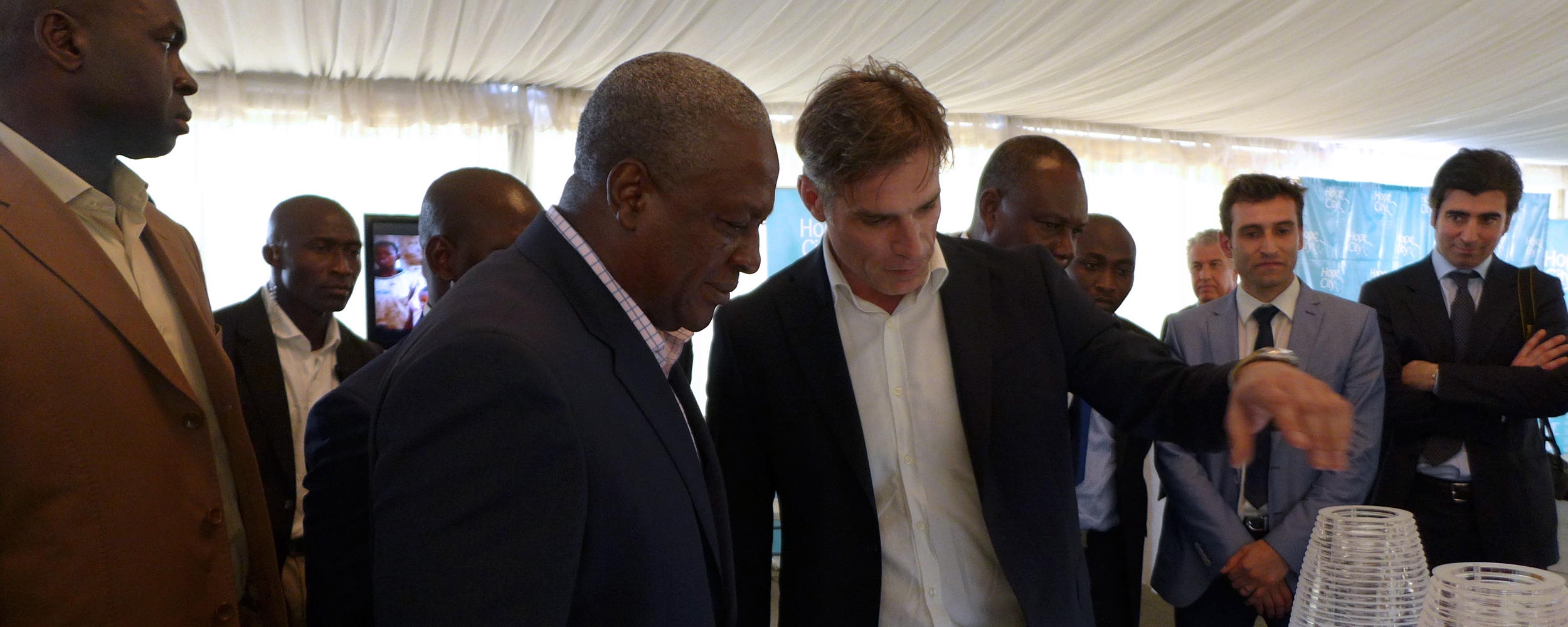 NEWS
NEWS

Paolo Brescia of OBR Architects explains the practice's design concept for HOPE City at the launch in Accra, Ghana, in early March 2013.
HOPE City IT hub in Accra designed by OBR launched
HOPE City, a £6.6 billion IT hub at Dunkonaa, a suburb of Accra, the capital of Ghana, intended to foster technological growth and attract firms in the global ICT sector to the West African country was launched earlier in March by Ghanaian President John Mahama. The Italian architectural practice OBR (Open Building Research), founded in 2000 by Paolo Brescia and Tommaso Principi, is designing the scheme, to be built within the next three years.
Roland Agambire, 39, one of Ghana’s leading businessmen, has spearheaded HOPE City, which is the acronym of Home Office People Environment, partnering with the Government of Ghana. The project has been followed with avid interest by the local media, and the launch celebrations included a concert at Ohene stadium to which American R&B singer Chris Brown was invited along with prominent Ghanaian musicians.
Agambire has said that he is ensuring HOPE City has an excellent modern design, and he is also keen to incorporate Ghanaian ingenuity and culture into the scheme’s architecture, he made clear at the launch ceremony. HOPE City is part of the national policy framework aimed at turning Ghana into a knowledge society and the government’s priority for infrastructure development, particularly in the areas of ICT and energy, and will also complement the national technology park being developed at Tema which is set to make Ghana the ICT hub in the sub region. It will offer technological, socio-cultural, touristic and investment opportunities for domestic and international investors, and enjoy tax incentives and reliefs, said the President.
Agambire’s company, local technology group RLG Communications, are financing 30% of the project, and a group of investors and a stock-buying scheme will fund the remainder. His intention is to make Ghana globally competitive. ‘HOPE City will provide work for 50,000 people and will host 25,000 inhabitant’, says RLG. The scheme includes an IT university for over 5000 students, 100 professors and over 50 staff, a residential area, a hospital and social and sporting amenities.
The site of HOPE City is a 1.5 million m2 area 30 minutes west of Accra’s city centre. The scheme will include six towers of different dimensions including a 75 storey, 270 metre high building that will be the highest in Africa. Two of the towers will be 60 storeys and the three others will be 42 storeys each. A system of bridges at different heights will link the towers, connecting their common functions and public amenities.
‘We want to re-create the feeling of traditional compound house of Ghana where the circular elements of the house are articulated around the same circular common space where the family becomes also the community – and that has been a feature of the African landscape for a long time’, explains Brescia. ‘HOPE City works at a different scale as a compound cluster, where people can feel part of the same large community, sharing the same values in the same common spaces. This is the essence of public space. Public spaces link people together, and this physically happens in this project linking different functions together. But the functions are not restricted in single dedicated buildings. Each building is designed by the overlapping of different functions, recreating a complexity similar to the city, where people can keep their own identity’.
‘It’s a vertical city, not a campus made up of single buildings dedicated to single functions’, he explains, like a typical suburban, low density business park. ‘The design brings different functions together, and so there people can have an interconnected life with horizontal as well as connections at different heights’. He thinks there is a lot of scope for experimentation in the scheme. ‘In Africa everything needs to be done in a way that starts from the traditions and life of the people, but updating it in a very contemporary way, keeping the common memory, which makes a space a place’. The typical Ghanaian house includes the barn, which represents the possibility of choice, said Brescia, explaining further OBR’s design concept for the new city, which will enhance, rather than be divorced from, the identity of Accra.
It is the combination of spaces at HOPE City that makes the scheme work. ‘We can recreate the same common space with the void. Instead of separate functions, you can link them, and have the overlap of spaces. The social spaces can be the link joining all these functions. It can be a shared space and a space of discovery. Agambire is very clear that work and life belong to the same sphere.’
HOPE City is being launched a few months after the breaking ground in Kenya of Konza Techno City, its own tech city scheme 60km south east of Nairobi, capitalizing on the country’s IT boom, and other IT hubs are being developed in Nigeria, Tanzania, Madagascar and Egypt.
Ghana was the first country in Africa’s sub-Saharan region to see Europeans arrive with the intent to trade, firstly for gold, and eventually slave trading. It was the first country in the region to become independent from its British colonizers in 1957.
The award-winning practice OBR is working on HOPE City with consultants Buro Happold and MIC. OBR works on urban design projects internationally in the public and private sector including social programmes for urban development in emerging economies, focussing on the promotion of a sense of community and widespread benefits in the built environment.